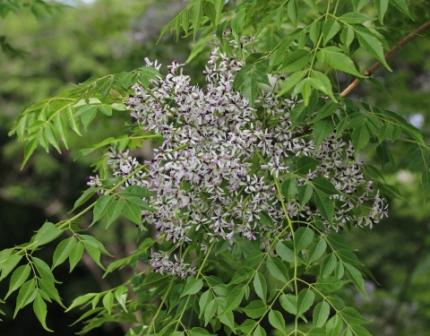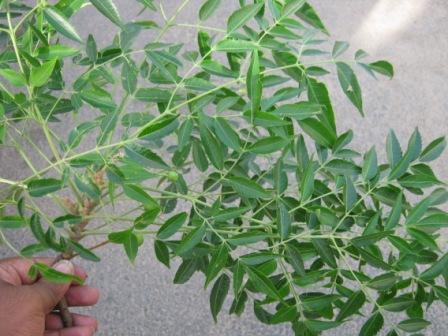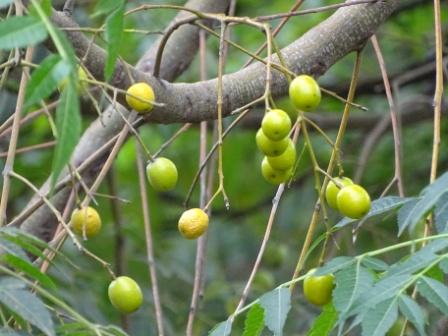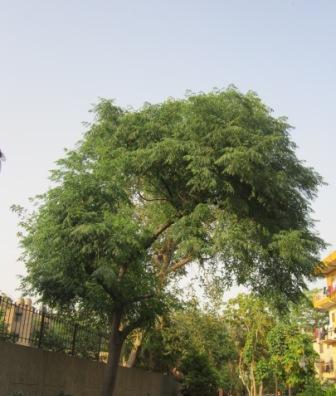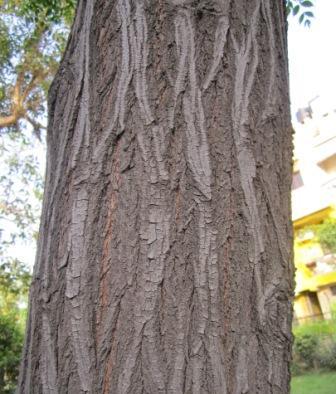Natural Regeneration :
- Naturally regenerated by seed only under favorable conditions.
Artificial Regeneration :
- Propagated by Nursery raised seedlings.
Seed collection and Storage :
- Seeds are collected from June to August.
- Fresh Fruits on collection should be depulped and shade dried.
- Seed weight is 3300-500/kg.
- Seed has less viability.
Seed Treatment :
- No seed treatment is required
Nursery Technique :
- Seeds of neem can be directly dibbled into polybags of size 20 x 10 cm or 20 x 15 cm with soil, sand and FYM in the ratio of 1:1:1 or 2:1:1.
- Soil with high clay content should be avoided.
- Fresh seeds should be graded and large size seeds are sown in polybags at the rate of two seeds per bag.
- After germination leaving the healthy one the other one is removed.
- Excess healthy seedlings can be used for pricking in containers where both the seeds have to germinate.
Plantation technique :
- One year old seedlings preferred for planting. Planting should be done in July-August during rainy period.
- Winter is unsuitable
Direct seeding -
- This is adopted for raising plantation for fuel wood and for the reclamation of wastelands. This could be done through (i) dibbling in bushes, (ii) broadcasting, (ii) sow lines, (iv) sowing on mounds or ridges, (v) sowing in trenches.
Polybags planting:
- In dry localities pits of 45 cm3 and in moist locality pits of 30 cm3 are dug for planting.
- Seedling of 6 -12 month old are out planted into the above pits during the rainy season.
- Pits can be filled with native soil along with 5 kg FYM and 25 to 50 g of DAP at planting for establishment and growth.
- Application of Bursbon in the planting pits will ward of any insect or termite attack during the period of drought.
- The spacing normally applied for Neem is 5 x 5 m or 10 x 10 m.
- Wider spacing is recommended for agro forestry practices.
Care & Disease Control :
- In dry localities watering and weeding are very essential during the first two years for proper establishment and growth.
Watering:
- Pot watering once in 10 days will help the tree to tide away the drought period.
- In saline soils watering during summer and periods of drought is necessary.
- Mulching around the tree basins with pebbles or available mulch in that area will help in conserving moisture.
Tending :
- Young seedlings should be free from weeds for early establishment and growth.
- Weeding helps to conserve moisture and nutrients in the soil for the tree to take up for its growth.
- Drawing of tractor drawn tillers in between trees will help to control weeds and conserve moisture.
- Weedings also help in loosening the soil for better aeration and root growth.
- In the naturally raised plantation thinning has to be done at the end of first year to space the seedling apart for initial growth and established.
- At the end of 2 - 3 year the trees are spaced at 3x3m or 5x5m depending on the locality.
- In the artificially raised plantation at the end of 5th year selective thinning can be taken up to cull out inferior trees and space the good trees at 10 x 10m spacing.
Irrigation :
For proper growth and survival it is necessary to give one or two waterings after planting. This is specifically required in arid regions. Irrigation after planting is not a prerequisite in areas having sufficient soil moisture and precipitation. Higher survival rate and better rate of growth is reported when soil and water conservation measures are also adopted
Recommended Harvest :
Yield :
Rotation: 10 years
Agro Forestory :
- M. azedarach is a useful species for growing with crops such as wheat.
- It has been successfully plantedwith sugarcane.
Major uses :
Timber:
1.Melia azedarach wood , which resembles mahogany, is used to manufacture agricultural implements, furniture, plywood, boxes, poles, tool handles; it is used in cabinet making and in construction because of its resistance to termites.
Medicine:
it is well known for its medicinal uses. Its various parts have antihelmintic, antimalarial, cathartic,emetic and emmenagogic properties and are also used to treat skin diseases. Dried ripe fruit is used as an external parasiticide; some toxic components are found in the seed oil, the oral intake of which may cause severe reactions and even death.
Other uses :
Lipids:
Oil suitable for illumination has been extracted experimentally from berries.
Fuel:
Fuelwood is a major use of M. azedarach. It has a calorific value is 5100 kcal/kg.
Fodder:
Leaves are lopped for fodder and are highly nutritious.
Market details :
- Approximately Rs.4500 to Rs.5000 / ton.
Carbon stock :
0.018 tC/Tree


